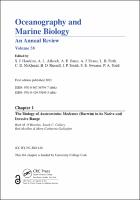Chapter 1 The Biology of Austrominius Modestus (Darwin) in its Native and Invasive Range
Proposal review
Contributor(s)
O'Riordan, Ruth M. (editor)
Culloty, Sarah C. (editor)
Mcallen, Rob (editor)
gallagher, mary catherine (editor)
Language
EnglishAbstract
Austrominius modestus, formerly Elminius modestus, is a relatively small species of four-plated acorn barnacle, which is native to the subtropical and temperate zones of Australasia. It was introduced into Europe in the 1940s, where its current range includes England, Scotland, Wales, Ireland and continental Europe from Denmark to southern Portugal, as well as two reported locations in the Mediterranean Sea. This species occurs intertidally and subtidally on a very wide range of substrata in both its native and introduced range and is found on sheltered to intermediate exposed shores, but is absent from wave-exposed shores, probably due to the relative fragility of its shell. A. modestus is known to be both euryhaline and eurythermal, but its physiology (and that of other cirripedes) has been relatively little studied in comparison with other invertebrate species. Cold temperatures and competition from arctic-boreal barnacle species currently control its northern limit. At the southern limit, desiccation stress, or some other stress(es), may be limiting the abundance of Austrominius modestus by affecting cyprids and/or metamorphs at the settlement and recruitment stages. Abundance may also be limited by factors occurring at the reproductive stage. Since Austrominius modestus is an obligatory cross-fertiliser, the need for a critical breeding density is one of the factors that appears to have slowed the speed of its spread in Europe. Although this species can commence reproducing at a very young age and under optimal conditions produces multiple broods per year, its fecundity has not yet been studied. An examination of the age of first brooding, the timing and size and number of broods per year at sites at the northern (Scotland) and southern (Portugal) limits of the current invasive range of Austrominius modestus may provide a better understanding of the factors controlling its geographic distribution, abundance and speed of spread in its non-native range. For instance, warming waters could result in increased reproduction and recruitment of Austrominius modestus, leading to a reduced density of the native Semibalanus balanoides Linnaeus which may drive Semibalanus balanoides to extinction in certain parts of its range. Further research is necessary to determine the functional role of Austrominius modestus in relation to native species in order to understand the implications that changes in abundance and distribution of A. modestus may have for ecosystems.
Keywords
Austrominius modestus, Elminius modestus, four-plated acorn barnacle, subtropical Australasia, Australasian marine life, invasive species, ecosystems, invertebrate speciesISBN
9780367367947, 9780429351495Publisher
Taylor & FrancisPublisher website
https://taylorandfrancis.com/Publication date and place
2020Grantor
Imprint
CRC PressClassification
Marine biology
Biodiversity
Environmental science, engineering and technology
Oceanography (seas and oceans)
Applied ecology
Biology, life sciences
Zoology: invertebrates


 Download
Download